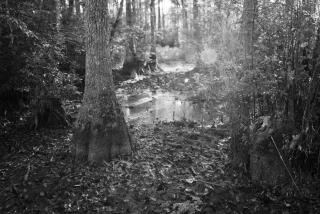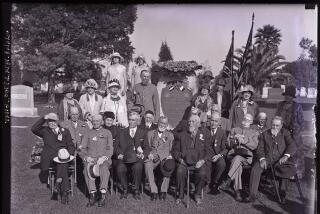The hellfire that spread across the land
John BROWN, the militant abolitionist who battled proslavery forces on the plains and led an assault on the federal arsenal at Harpers Ferry in the hope of inciting a slave insurrection, has always aroused powerful and conflicting emotions. An earlier generation of scholars, who saw the Civil War as needless carnage brought on by irresponsible fanatics, made Brown exhibit No. 1 -- a madman, criminal or, in today’s lexicon, a terrorist who inflamed sectional hatred. Even today, when most historians view the Civil War as an irrepressible conflict rooted in the slavery controversy, visitors to the exhibit on “Terror in America” at the International Spy Museum in Washington, D.C., encounter Brown alongside Klansmen, anarchists and Islamic extremists.
To Northern intellectuals of the time such as Ralph Waldo Emerson and Henry David Thoreau, Brown was an example of moral action in a crass, commercialized world. Brown’s execution, Emerson wrote, made “the gallows glorious like the cross.” Since Brown’s death, radicals of the left and right, including Eugene V. Debs, the Weather Underground and antiabortion activists, have revered him as a man willing to take up arms against an immoral institution. African American leaders long have hailed Brown as the rare white person willing to sacrifice himself for the cause of racial justice. Stokely Carmichael named Brown and radical Republican Thaddeus Stevens as the only white figures in U.S. history worthy of African American admiration.
David S. Reynolds, a professor of English and American studies at City University of New York, is Brown’s latest convert. The author of several works on 19th century literature, including “Walt Whitman’s America,” Reynolds calls this book a “cultural biography,” tracing Brown’s dynamic relationship to the society, politics, literature and religion of his day. He details how others viewed Brown and how Brown influenced his age. He concludes that in his religious and racial views and violent methods, Brown was unique.
A lively writer, Reynolds expertly chronicles the course of Brown’s life. Born in rural Connecticut in 1800, Brown grew up in a devoutly Christian family in which he was taught to pray daily, regard slavery as a sin and treat blacks as equals. His life reminds us that deep religious conviction can be the seedbed of political radicalism, not only the conservatism we witness today. Brown’s religion, however, differed from that of other abolitionists, who were inspired by the religious revivals of what came to be known as the “Second Great Awakening” in the 1820s. They became persuaded of their ability to convince slave owners to abandon their sinful ways. Brown’s God, however, was not the forgiving Jesus of the New Testament but the vengeful Jehovah of the Old. He saw himself, writes Reynolds, as a “Puritan warrior,” like England’s Oliver Cromwell, called by God to stamp out slavery by violence.
Brown also became, Reynolds argues, one of a handful of whites to repudiate completely his era’s pervasive racism. He not only demanded political and social equality for blacks but lived his life according to this principle. He welcomed blacks into his home, aided impoverished black neighbors and in the 1840s moved his family to North Elba, N.Y., where philanthropist Gerritt Smith had made plots of land available to black settlers to help them achieve economic independence.
“The clan raised by John Brown,” Reynolds writes, “was the only white family in pre-Civil War America willing both to live with black people and to die for them.”
Brown devoted his adult life to crusading against slavery. He joined the Underground Railroad and assisted fugitive slaves. When violence broke out in 1854 between proslavery and antislavery settlers in the territory of Kansas, Brown and three of his sons joined the fight. There, in his most controversial act, he and his followers murdered five proslavery settlers alongside Pottawatomie Creek. Reynolds calls the killings indefensible but insists that they must be understood in the context of the violence raging in Kansas and Brown’s conviction that slavery itself amounted to a state of war.
Brown’s attention next turned to the Harpers Ferry enterprise, for which he gathered recruits among abolitionists as well as blacks who had fled to Canada to escape the fugitive slave law. He persuaded some of the leading figures in Massachusetts society, among them cotton magnate Amos Lawrence and the Rev. Theodore Parker, to contribute funds. They had little real idea what Brown was up to, but as Reynolds explains, they believed “the times called for an antislavery soldier who would stand up to the South.”
On Oct. 16, 1859, Brown led his band of 22 men to seize the federal arsenal in Virginia. The raid was a fiasco. No slaves joined them and they were quickly subdued by local militia and a squadron of Marines headed by Col. Robert E. Lee. Brown was wounded, placed on trial for treason and executed.
Though it was a military failure, the raid transformed Brown, in the North at least, into a folk hero, immortalized in poetry, song, visual images and legend. In keeping with his concern for cultural influence, Reynolds devotes much of the book to tracing contemporary reactions to and representations of Brown. Unfortunately, unlike the narrative of his life, the account of the “memory” of John Brown is disjointed and repetitious. The excerpts from bad poetry about his deeds become tedious and the claims for influence are often speculative. (Does Brown’s raid really explain how Emily Dickinson came to write her best poetry?) But it is fascinating to read of Brown’s long-term effect on African American poets, artists and political leaders.
Most books on John Brown are strongly partisan, and this one is no exception. Reynolds’ account brims with passion and conviction. However, beginning with his rather hyperbolic subtitle, “The Man Who Killed Slavery, Sparked the Civil War, and Seeded Civil Rights,” he tends to exaggerate Brown’s uniqueness and influence. It is not true, as Reynolds claims, that the secession movement became “well organized” only in reaction to the raid on Harpers Ferry, or that Brown’s act was crucial to Abraham Lincoln’s 1860 electoral victory. (Republicans solidified their voting majority in the North in the 1858 congressional elections.) Reynolds also links Brown’s religious convictions to Lincoln’s comment in his second inaugural address that the Civil War could be seen as divine punishment by a righteous God. He fails to note that Lincoln also commented that man does not know God’s will -- the opposite of Brown’s religious certitude.
To highlight Brown’s humanitarianism, Reynolds denigrates other white abolitionists as “racists who did not like working with blacks” -- a considerable exaggeration. Even Thaddeus Stevens, a lifelong advocate of black rights, is caricatured as supporting black suffrage “chiefly as a means of punishing the South.” Reynolds also portrays Brown as an advocate of equality for Native Americans, even though his encouragement of the influx of white settlers into Kansas inevitably meant the dispossession of the Indian population, and also for women -- an odd claim for the father of 20 children who left his second wife to fend for herself in frigid North Elba while he crisscrossed the North on his antislavery mission.
Reynolds’ account of the Harpers Ferry raid seems to give Brown the benefit of what should be serious doubts. Slavery was a minor presence in the mountainous area of Virginia where the arsenal was situated, and none of the few slaves who lived there opted to join Brown. Reynolds chides Brown for being “overconfident,” but he almost seems to blame those slaves for its failure -- they were too “confused” and fearful to seize the opportunity presented them.
Lincoln offered a more realistic appraisal: “It was an attempt by white men to get up a revolt among slaves, in which the slaves refused to participate. In fact, it was so absurd that the slaves, with all their ignorance, saw plainly enough that it could not succeed.”
Whatever one thinks of John Brown, it cannot be denied that he was a courageous man with one penetrating insight: Slavery was a system of violence that could not be eradicated peacefully. “Nothing but war can settle the question,” Brown once wrote. Reynolds ends his book with a simple statement by W.E.B. Du Bois: “John Brown was right.” *
More to Read
Sign up for our Book Club newsletter
Get the latest news, events and more from the Los Angeles Times Book Club, and help us get L.A. reading and talking.
You may occasionally receive promotional content from the Los Angeles Times.







